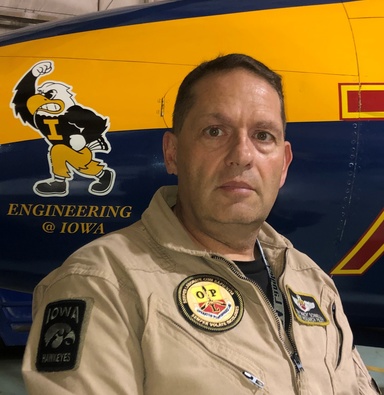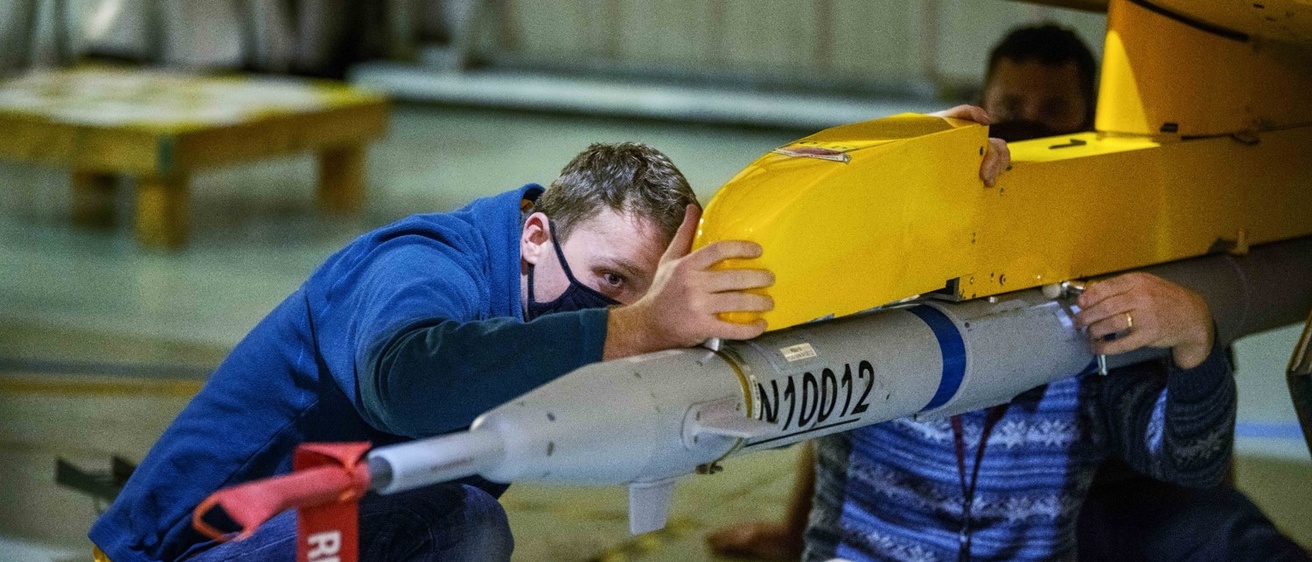IOWA CITY, IA – The University of Iowa Technology Institute’s Operator Performance Laboratory (OPL) recently supported the first rounds of flight tests of an air combat training system designed to prepare U.S. Navy and Air Force pilots and crews for aerial combat.

Collins Aerospace, a unit of Raytheon Technologies Corp. with locations in Cedar Rapids, Iowa, enlisted OPL as it develops the Tactical Combat Training System Increment II, or TCTS-II, for the Navy and Air Force.
“Fundamentally, we execute a pre-defined profile that includes flying to specific ranges to see how far the data link can work, and with what reliability,” said Tom “Mach” Schnell, the Jim "Max" Gross Chair in Engineering and OPL founder and director. “Then we do certain dynamic maneuvering, fundamentally acrobatic maneuvers resembling those of aerial combat, to see if the inertial system on the pod is accurate.”
Based in two hangars at the Iowa City Municipal Airport, OPL has built an international reputation as an academic lab specializing in flight testing. OPL and Collins have become important partners advancing military and commercial avionics systems over more than two decades since Schnell first arrived at Iowa.
In November, the Collins and OPL team continued their test work on the TCTS-II system, mounting cylindrical-shaped pods holding the TCTS-II hardware to the wings of OPL’s two L-29 Delfin jets.
The L-29s are equipped with F/A-18 radar simulators and displays, mimicking relevant functions of the tactical jet at a small fraction of the operational cost of the F/A-18, one of the military aircraft for which the TCTS-II is ultimately intended.
TCTS-II was created to enable pilots and crews, from individuals up to large groups, to experience live air-to-air and air-to-surface engagements without deploying actual weapons. Pilot tactics and reactions can be tracked and used to improve accuracy, decision-making, and safety. Collins often attaches the slogan “train like you fight” to the program.
For TCTS-II to work, aircraft and ground control need to be able to communicate and “see” each other within the range, a term used to describe the area where the aerial engagements take place.
After hours of testing to ensure the pods worked on land, test pilots Schnell, Patrick “Dice” Highland, and Brad “Bacon” Tribley took to the sky, while controller Brooke “Sunny” Farrington orchestrated the movements of the aircraft from a control room at OPL. Another team of engineers at Collins in Cedar Rapids monitored reliability of the data links between the jets and the ground.
“We're putting electronic pods on the aircraft and flying them through tactically relevant maneuvers to evaluate the technical readiness of a system involving multiple aircraft and complex range instrumentation,” said Highland, an Air Force-trained test pilot pursuing a PhD in industrial and systems engineering at OPL.
Ty Bachmann, director of flight testing for Collins, praised the relationship between the federal government, academia, and industry on the TCTS-II project as “absolute goodness.”
“That’s us using taxpayer dollars to the maximum extent possible for the good, for everyone,” Bachmann said. “Further, the TCTS-II system is an absolute leap in training capability from the previous system. What the TCTS-II system will bring to not only the F/A-18 to start, but Air Force platforms and all the other platforms across the inventories throughout the years is going to be significant and a training multiplier for the services.”

Where OPL excels – leveraging equipment like the L-29s, its two Mi2 helicopters, and other aircraft – is in identifying and troubleshooting flaws early in the testing process so they can be fixed before the product matures to a point at which changes are far more costly and time consuming.
“One of the benefits of doing this at OPL is technical risk reduction for the program,” Bachmann said. “We find and learn right now where the failure points are in the system prior to handing it over to the U.S. government who will then operate the system on F/A-18s.”
TCTS-II testing continued on F/A-18s at the Naval Air Station Patuxent River Navy Base in Lexington Park, Md., in December 2020, with additional testing throughout much of 2021.
The Department of Defense categorizes the project as ACAT-II, a defense acquisition considered to be a major system valued exceeding either $200 million in research and development or $920 million in procurement costs.
